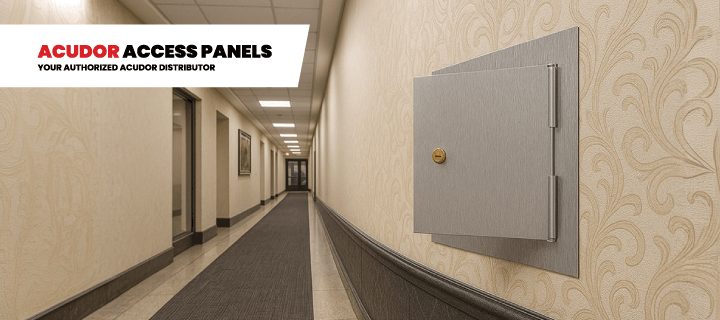How Tamper-Proof Access Panels Reduce Liability and Ensure Compliance in High-Traffic Projects Posted by Acudor Access Panels on 3rd Nov 2025
Tamper-proof access panels reduce liability in public spaces by preventing unauthorized access and protecting critical systems from vandalism or damage.
Safety and accountability come first in facilities such as schools, hospitals, airports, and correctional institutions. Every access point is a potential vulnerability in these buildings.
One poorly secured door can expose essential systems, compromising a building's integrity and triggering expensive liability claims.
Security-grade solutions like the SD-6000 Security Access Door are designed for such use cases. They're built from heavy-duty steel and fitted with tamper-resistant locks, which help facilities maintain security, compliance, and peace of mind.
Why Are Tamper-Proof Access Doors Critical in High-Traffic Facilities?
Tamper-proof access doors are critical because they prevent unauthorized entry, safeguard essential systems, and protect building owners from potential safety incidents and liability.
Standard access panels can buckle, loosen, or pry open in high-traffic environments under repeated stress. This puts power systems, HVAC controls, or fire-suppression infrastructure, etc, at risk of tampering, vandalism, or accidental interference.
The result? Downtime, inspection failures, or worse, injuries that trigger insurance claims and lawsuits.
Tamper-proof panels prevent these chain reactions by combining vandal-resistant design and impact-rated materials with controlled access hardware. Their duty rating and welded steel construction allow them to handle daily use without compromising integrity.
Keep your systems secure and compliant in high-traffic spaces. Explore our full line of heavy-duty, security access panels built for safety and reliability.
Related: Which Acudor Access Panels Are Best for High-Security Applications?
How Do These Doors Support Compliance and Reduce Liability?
Tamper-proof access doors support compliance and reduce liability by combining reinforced construction, secure locking systems, and safety-rated materials that meet public building standards.
1. Reinforced Frame Construction for Structural Integrity
Welded or fully reinforced steel frames resist prying, twisting, and impact. This helps meet the structural integrity provisions under the International Building Code (IBC) for public installations.
Welded frames maintain rigidity even in high-use environments like corridors or mechanical rooms. This strength also reduces liability during inspections and maintenance.
2. Tamper-Resistant Locks for Controlled Access
Locks address compliance and accountability. Codes such as OSHA 1910.303(g) and NFPA 70E require that only qualified personnel access live or hazardous systems.
Tamper-proof access doors satisfy that expectation with secure locking mechanisms—these range from standard cylinder locks to detention-grade hardware and tamper-resistant screws.
These options limit access to approved maintenance staff and professionals, reducing liability caused by injury or equipment damage from unauthorized entry.
3. Heavy-Duty Materials for Long-Term Durability
Heavy-gauge steel or reinforced aluminum panels carry high duty ratings. They're built to withstand daily impact without deforming or compromising their seal.
That resilience protects against routine wear and vandalism, ensuring the panel continues to perform to its code classification. This includes secure sound-rated or fire-rated options or both. Less damage means fewer repairs, fewer openings, and fewer chances for safety lapses.
4. Corrosion-Resistant Finishes for Hygiene and Longevity
Environments like hospitals, food service areas, and transportation hubs demand both hygiene and endurance. Factory-applied powder coatings and galvanized or stainless-steel finishes protect against corrosion and make cleaning easier.
Easy cleaning means higher sanitation standards for these commercial spaces. A smooth, sealed surface also resists grime buildup, which can interfere with hinges and locks.
5. Fire-Rated Designs That Preserve Code Integrity
Many public facilities require that openings in fire-rated assemblies maintain their protection level. Tamper-proof, fire-rated access door models are tested under ASTM E119 or UL 10B to ensure that adding an access panel doesn't downgrade the wall's or ceiling's fire rating. By so doing, they prevent inspection failures.
6. Customization Options for Specific Needs
No two facilities have identical compliance requirements. That's why many manufacturers offer customizable options that help specifiers align product performance with regulatory needs:
- Locking Systems: Keyed cylinders, detention locks, cam latches, or tool-operated fasteners for various security levels.
- Material and Gauge Selection: From 16-gauge steel for detention environments to lighter-duty panels for administrative areas.
- Size and Mounting Configurations: Custom sizes and tailored mounting features to match mechanical layouts or retrofit conditions.
- Finishes: Coatings and finishes that satisfy project-specific standards.
Custom configurations allow general contractors and facility managers to meet design intent and compliance requirements without compromising aesthetics or accessibility.
When compliance and liability protection matter, every detail counts, from welded frames to the right lock type. Request a quote today to specify tamper-proof access doors built for security, durability, and code integrity.
Which Industries Benefit Most From Security Access Doors?
Facilities with high public interaction or sensitive operations benefit most from tamper-proof access panels.
- Schools and Universities: Students and staff occupy spaces daily, making controlled access essential. Vandal-resistant doors prevent interference with utilities, lab systems, or communications wiring.
- Correctional Facilities: Security access doors must withstand deliberate tampering. Welded frames and detention-grade locks ensure containment and compliance with correctional safety standards.
- Hospitals and Healthcare Centers: Here, they help protect medical gas lines, electrical feeds, and HVAC systems without compromising hygiene or accessibility. Smooth finishes and cleanable surfaces maintain sanitary environments.
- Airports and Transportation Hubs: Tamper-resistant panels provide high-impact resistance and consistent functionality even under round-the-clock operations.
- Public and Government Buildings: Security panels help comply with municipal safety codes and inspection requirements.
Related: What to Look for When Choosing an Acudor Access Door for Healthcare Facilities
How Does the SD-6000 Prevent Unauthorized Access?
The SD-6000 Security Access Door by Acudor has multiple features that prevent unauthorized access in sensitive areas:
- A 10-gauge steel panel construction that resists impact, prying, and forced entry, giving facility managers confidence that critical systems stay protected even in high-risk areas.
- The welded frame and security hinges keep the door square and secure under stress, maintaining the structural integrity required in public and correctional environments.
- Its detention-grade deadbolt with restricted key profiles prevents unauthorized duplication and enforces controlled access.
- Engineered to meet IBC structural integrity provisions, the SD-6000 supports public safety standards that reduce inspection failures and liability.
- The 5-stage iron phosphate prep and baked enamel coating protect against corrosion and wear, extending product life in demanding environments.
Frequently Asked Questions About Tamper-Proof Panels
1. What makes a panel tamper-proof?
A tamper-proof panel is built from heavy-duty materials and fitted with locking mechanisms that resist forced entry. Features like welded frames, flush doors, and concealed hinges eliminate pry points, ensuring only authorized users can open them.
2. Are tamper-proof access panels code-compliant?
When specified correctly, tamper-proof access panels are code-compliant. They meet IBC, NFPA, and OSHA requirements for access to controlled mechanical, electrical, and plumbing systems. Models tested under ASTM or UL standards maintain fire ratings, ensuring compliance in public or high-traffic facilities.
3. Where can security panels be installed?
They're ideal for public and high-traffic buildings requiring durability and tamper resistance. These include schools, hospitals, airports, correctional facilities, and municipal complexes.
4. How do tamper-proof panels reduce liability?
By preventing unauthorized access, they minimize incidents that lead to injury, damage, or regulatory breaches, thereby reducing exposure to claims and fines.
Conclusion
Tamper-proof access panels prevent tampering, safeguard critical systems, and support code compliance. And they do so while maintaining clean aesthetics and ease of use for authorized teams.
Specifying the right access door reduces contractors' liability and encourages accountability among facility managers. Welded frames, tamper-resistant locks, and heavy-duty construction are some features to look out for.
Professional installation is also key to ensuring every panel you install performs exactly as intended.
In high-traffic environments, prevention is always better than correction. Talk to our team about code-compliant access solutions for public or institutional facilities. Call +1-888-617-4472 today.
Acudor Access Panels is a trusted and authorized distributor of Acudor products. We proudly bring you their full range of industry-leading access doors and panels.





